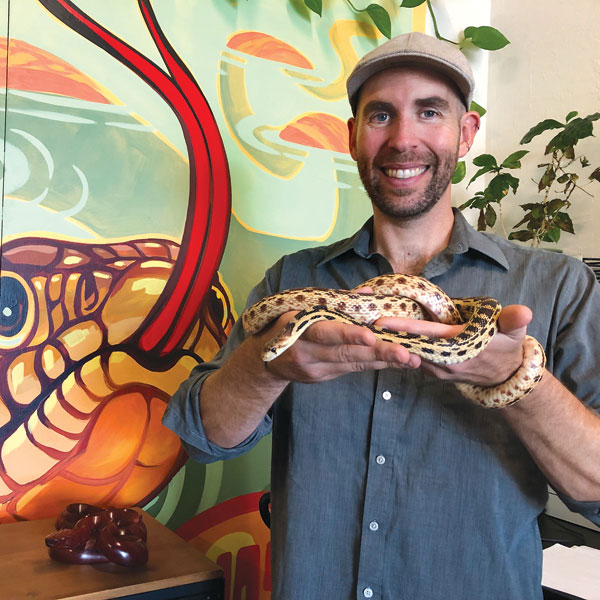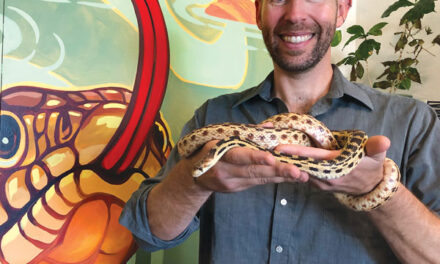California has a state bird, bat, amphibian, reptile, crustacean, flower, grass, mushroom, tree, insect, slug, seashell, rock—but no snake.
Michael Starkey wants to change that with the giant garter snake.
Reaching 64 inches long, the giant garter snake is a threatened species found only in the Central Valley. He lives in freshwater marshes, such as Yolo County’s flooded rice fields. He eats fish and amphibians, including the invasive American bullfrog.

“Designating the giant garter snake as California’s official state snake is more than a symbolic gesture. It’s a crucial step in raising awareness about this vulnerable species and its vital role in our state’s ecosystems,” says Starkey, founder and executive director of the Sacramento-based nonprofit Save The Snakes.
Starkey, who grew up in Natomas, was “obsessed with snakes.” His parents gave him a room to keep and breed 50 to 60 snakes. His first job was in a pet store.
A year after high school, a local wildlife biologist gave Starkey a summer job tracking giant garter snakes. “That field work changed my life,” he says. “Seeing them in the wild, I suddenly didn’t feel very comfortable with my snakes in boxes at home.”
After studies in field biology at Sacramento City College, Starkey’s wildlife conservation efforts took him to Panama, Africa and Belize.
His conservation work with amphibians launched the idea of creating something similar for snakes. “Snakes are another species that needs help, just like frogs, pandas, elephants. Every species has problems. Just some are more charismatic than others.”
Save The Snakes’ first endeavor raised funds to help “globally vulnerable” king cobras in India. Since 2018, Save The Snakes has supported 40 projects in 20 countries with seed grants, helping local conservationists protect snake populations and mitigate human-snake conflicts.
Save The Snakes took on more meaning when the World Health Organization declared snake bites a neglected tropical disease in 2017.
“If snakes are going to be listed as a disease vector, you can imagine what that would do for the popularity of snakes,” Starkey says. “Snakes are already controversial. It doesn’t matter if people don’t like snakes, we still need snakes. They are incredibly important animals for our ecosystems.”
Sacramento has numerous snake species, including one venomous snake—the northern Pacific rattlesnake.
All other snakes common to Sacramento are harmless. They include the Pacific gopher snake, California king snake, yellow-bellied racer, sharp-tailed snake (good for gardens, they eat slugs), and three garter snakes—valley, wandering and giant.
In 2021, Save The Snakes opened a Snake Conservation Center in Rancho Cordova offering educational workshops for the public and specialized training courses to military, park service employees and other professionals who encounter snakes. The fee-based classes make up 50% of the organization’s budget.
“A lot of our messaging is prevention of snake bites. The venomous snake training program brought our organization to a new level,” Starkey says.
The Snake Conservation Center houses 24 snakes, including an 8-foot coastal carpet python, delicate green rhinoceros rat snake, iridescent-blue reticulated python, shiny black indigo snake and six rattlesnakes.
Johnny Cash and June are western diamondbacks native to Southern California. “His personality matches his name,” Starkey says. “We have to walk the line with him.”
The center is not a zoo or nature center, Starkey explains. “These animals don’t need to please audiences.” More than 25 volunteers and interns from UC Davis and Sacramento State assist with their care.
“All of our snakes have come from, for the most part, where they were not wanted,” Starkey says. Some were surrendered as pets, dumped in parks or found where they don’t belong.
For those who want a snake, Starkey recommends adopting from a local animal shelter, reptile sanctuary or herpetology society. “They live a long time. People are not prepared,” he says.
For Starkey, a full-time wildlife biologist and consultant, Save The Snakes is “a hobby on steroids.” He says, “We are trying to help people live in harmony with nature. If we go out in nature, we may encounter snakes. Instead of killing them, there are other things you can do.”
For information on classes, volunteering, donating and Senate Bill 765, which would establish the giant garter snake as the state snake, visit savethesnakes.org.
Cathryn Rakich can be reached at crakich@surewest.net. Follow us on Facebook and Instagram: @insidesacramento.
















